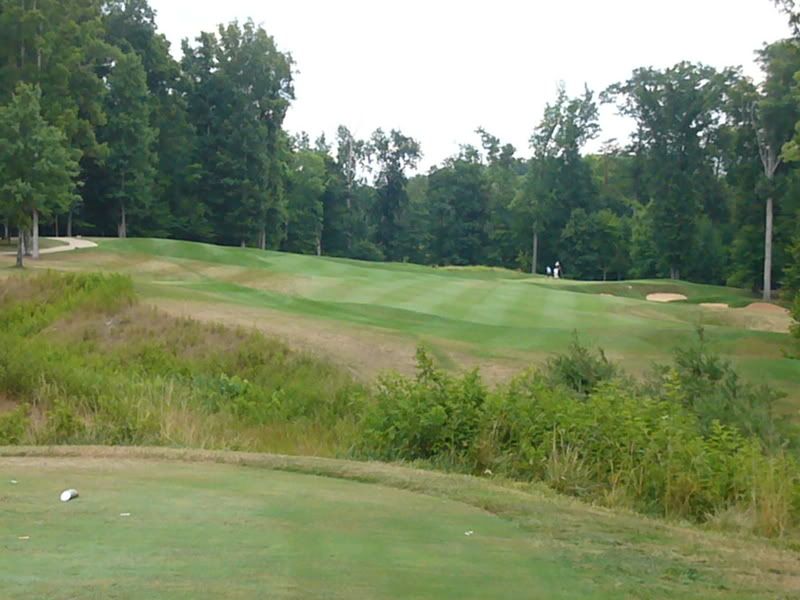This is the 285 / 264 / 250 yard par 4 14th hole on Westfields in Clifton, VA. Designed by Gene Bates and Fred Couples, it's driveable, but if you miss you likely have a not impossible but challenging up and down. It's a "baby" hole: not long and not penal.
But that doesn't mean it's not a lot of fun -- or a pushover.
I like it because it kills via the subtle method of "unreasonable expectations:" eagle and birdie are real options here even as 6 and 7 aren't (or shouldn't be!), but the golfer who pulls driver or 3 wood calibrates his expectations to eagle so that even birdie may disappoint, par and bogey eviscerate. How many holes have you played driver off the tee
with the expectation of eagle?! There's obviously no rule you have to hit driver instead of, say, two consecutive baby wedges, but the view from the tee is red meat to the caveman golfer that lurks somewhere in the brain of every golfer. We can't help ourselves.
The risk doesn't appear so great from the tee -- there's no great heroism asked of the tee shot -- the penalty for a missed drive is inherently strategic rather than penal: a missed tee shot presents an approach shot made harder due the challenging angle to the green.
The best way to drive the green is via a slingshotting "ground fade" (for righties). The green entrance is front left and is positioned to receive a tee shot bounding down the hillside -- assuming proper angle and spin.
View from right side of tee, where easier tees normally are placed; from this angle the play is a slingshot fade that uses the severe sidehill as a guide down to the green
The hole is made more difficult from the two back tees not so much via length but via angle. Instead of an easy-on-the-eyes slingshotter from the right side, back tees are placed to the left, asking the golfer to hit a reasonably straight "fade" (i.e., a pro fade not a chop's "power fade"). The trees on the left pretty much eliminate the option of a cut fade or outright slice.
It gets interesting when the golfer actually stops to think what type of shot he must hit with the driver. For many of us, this thought process literally is too little too late. Upon setting eyes on the hole, most will dispense with anything approaching "decisionmaking," choosing driver immediately, it's so obviously short and easy! But then a subtle and therefore highly corrosive half-conscious thought process begins. First thoughts of "bomb it" segue to "sling shot it" and finally -- not realizing he's been drawn into the subtlest of traps, the "oh I'll hit it anyway trap" -- "baby fade it." Three thoughts on one tee, uh oh.
View from left side of tee -- marker shown defines right edge of teeing area
Part of the challenge is visual: golfers take in the slingshot fade that must be tacked on
at the end of their shot and what do they do? That's right, they process the "fade" part of the information and proceed to jack a big block or block fade. And then you're dead, you just don't know it yet: a little flip wedge shot out of the rough to an elevated green with a bunker in front. Furthermore, this position presents a shallow green. Ugly!
Closer view of slingshot approach and green; green is a good 10-15 feet lower than hill
In sum, this is one of those holes that make you want to march right back up the fairway and immediately play again.
Mark